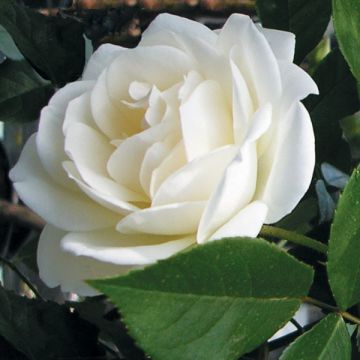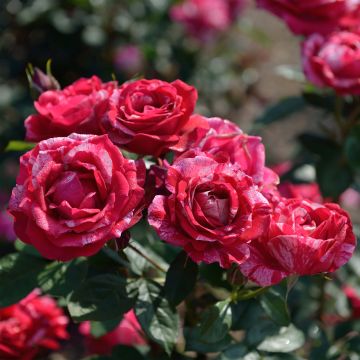

Rosa Nostalgie - Stem Hybrid Tea Rose


Rosa Nostalgie - Stem Hybrid Tea Rose
Rosa Nostalgie - Stem Hybrid Tea Rose
Rosa Nostalgie®
Hybrid Tea Rose
Arrived in perfect condition, height of 1.50m, just need to plant it for the nostalgia to kick in!
FaFa, 16/10/2024
Special offer!
Receive a €20 voucher for any order over €90 (excluding delivery costs, credit notes, and plastic-free options)!
1- Add your favorite plants to your cart.
2- Once you have reached €90, confirm your order (you can even choose the delivery date!).
3- As soon as your order is shipped, you will receive an email containing your voucher code, valid for 3 months (90 days).
Your voucher is unique and can only be used once, for any order with a minimum value of €20, excluding delivery costs.
Can be combined with other current offers, non-divisible and non-refundable.
Home or relay delivery (depending on size and destination)
Schedule delivery date,
and select date in basket
We guarantee the quality of our plants for a full growing cycle, and will replace at our expense any plant that fails to recover under normal climatic and planting conditions.

Description
A magnificent rose for bouquets or the garden. The 'Nostalgie' Rose stands out for the perfect shape of its turbinate flowers, its fragrance and delicate colours, in an elegant harmony, with cherry red-edged petals enveloping a delightful cream heart, with a delicious fragrance. It is undoubtedly one of the most beautiful perpetual varieties, flowering from June until the first frost. The foliage is healthy, highly resistant to diseases. With a medium size, it is suitable for the back of perennial borders and will easily blend into a flowering hedge.
This bush with a rather upright habit reaches alomst 90 cm (35in) in all directions, with rapid growth. Its foliage and vigorous young stems, adorned with large brown thorns, emerge in a reddish bronze colou before turning a fairly dark green shade. It is remarkably healthy. From June to the first frost, if faded flowers are removed, the compound flowers with 40 petals, measuring 8 cm (3in) in diameter, emerge from cherry red buds, then gradually open to reveal a tightly packed cream centre within a cherry red-edged corolla. They are solitary or grouped in clusters of three
This 'Nostalgie' Rose forms a small bush, ideal for planting as a solitary specimen. It integrates well in borders, or mixed with light perennials and annuals such as paniculate gypsophila, paniculate phlox, or love-in-a-mist. It will be beautifully showcased in front of a boxwood or yew screen, or, on the contrary, surrounded by a miniature hedge or a carefully organised maze, as in Italian or French gardens. It is also, above all, a magnificent rose for creating lovely and romantic bouquets.
Bred by Tantau in 1996.
Report an error about the product description
Rosa Nostalgie - Stem Hybrid Tea Rose in pictures


Plant habit
Flowering
Foliage
Botanical data
Rosa
Nostalgie®
Rosaceae
Hybrid Tea Rose
Cultivar or hybrid
Planting and care
Plant your 'Nostalgie' Rose in a sunny or lightly shaded location. Modern roses are tolerant but do not appreciate excessive limestone. They will adapt to any garden as long as the soil is well-worked, not too heavy, and sufficiently rich. To plant your rose, work the soil well, crumble it, and place an amendment at the bottom of the planting hole, such as dried blood or dehydrated horn. Water abundantly after planting to remove air pockets. Water regularly for a few weeks to facilitate rooting.
Pruning modern perpetual roses is essential for flowering. It is done in three steps:
1. Maintenance pruning: regularly shorten the branches that have bloomed during the season. To promote the re-blooming of perpetual roses, remove the faded flowers along with their stem, leaving 2 or 3 leaves.
2. Preparatory pruning in autumn: light pruning that anticipates the true spring pruning. In regions with cold winters, this is not recommended to avoid weakening the bush.
3. Spring pruning: in February-March, when the buds have become shoots that are 2 to 3 cm (1in) long: prune the young strong branches to a quarter of their length.
Pruning always aims to clear the heart of the bush and remove dead wood, diseased branches, and weak shoots. The most vigorous ones will be kept, usually 3 to 6 well-positioned branches to maintain a beautiful habit. Always prune at an angle, ½ cm or 1 cm (<1in) above an outward-facing bud.
Planting period
Intended location
Care
-
, onOrder confirmed
Reply from on Promesse de fleurs
Similar products
Haven't found what you were looking for?
Hardiness is the lowest winter temperature a plant can endure without suffering serious damage or even dying. However, hardiness is affected by location (a sheltered area, such as a patio), protection (winter cover) and soil type (hardiness is improved by well-drained soil).

Photo Sharing Terms & Conditions
In order to encourage gardeners to interact and share their experiences, Promesse de fleurs offers various media enabling content to be uploaded onto its Site - in particular via the ‘Photo sharing’ module.
The User agrees to refrain from:
- Posting any content that is illegal, prejudicial, insulting, racist, inciteful to hatred, revisionist, contrary to public decency, that infringes on privacy or on the privacy rights of third parties, in particular the publicity rights of persons and goods, intellectual property rights, or the right to privacy.
- Submitting content on behalf of a third party;
- Impersonate the identity of a third party and/or publish any personal information about a third party;
In general, the User undertakes to refrain from any unethical behaviour.
All Content (in particular text, comments, files, images, photos, videos, creative works, etc.), which may be subject to property or intellectual property rights, image or other private rights, shall remain the property of the User, subject to the limited rights granted by the terms of the licence granted by Promesse de fleurs as stated below. Users are at liberty to publish or not to publish such Content on the Site, notably via the ‘Photo Sharing’ facility, and accept that this Content shall be made public and freely accessible, notably on the Internet.
Users further acknowledge, undertake to have ,and guarantee that they hold all necessary rights and permissions to publish such material on the Site, in particular with regard to the legislation in force pertaining to any privacy, property, intellectual property, image, or contractual rights, or rights of any other nature. By publishing such Content on the Site, Users acknowledge accepting full liability as publishers of the Content within the meaning of the law, and grant Promesse de fleurs, free of charge, an inclusive, worldwide licence for the said Content for the entire duration of its publication, including all reproduction, representation, up/downloading, displaying, performing, transmission, and storage rights.
Users also grant permission for their name to be linked to the Content and accept that this link may not always be made available.
By engaging in posting material, Users consent to their Content becoming automatically accessible on the Internet, in particular on other sites and/or blogs and/or web pages of the Promesse de fleurs site, including in particular social pages and the Promesse de fleurs catalogue.
Users may secure the removal of entrusted content free of charge by issuing a simple request via our contact form.
The flowering period indicated on our website applies to countries and regions located in USDA zone 8 (France, the United Kingdom, Ireland, the Netherlands, etc.)
It will vary according to where you live:
- In zones 9 to 10 (Italy, Spain, Greece, etc.), flowering will occur about 2 to 4 weeks earlier.
- In zones 6 to 7 (Germany, Poland, Slovenia, and lower mountainous regions), flowering will be delayed by 2 to 3 weeks.
- In zone 5 (Central Europe, Scandinavia), blooming will be delayed by 3 to 5 weeks.
In temperate climates, pruning of spring-flowering shrubs (forsythia, spireas, etc.) should be done just after flowering.
Pruning of summer-flowering shrubs (Indian Lilac, Perovskia, etc.) can be done in winter or spring.
In cold regions as well as with frost-sensitive plants, avoid pruning too early when severe frosts may still occur.
The planting period indicated on our website applies to countries and regions located in USDA zone 8 (France, United Kingdom, Ireland, Netherlands).
It will vary according to where you live:
- In Mediterranean zones (Marseille, Madrid, Milan, etc.), autumn and winter are the best planting periods.
- In continental zones (Strasbourg, Munich, Vienna, etc.), delay planting by 2 to 3 weeks in spring and bring it forward by 2 to 4 weeks in autumn.
- In mountainous regions (the Alps, Pyrenees, Carpathians, etc.), it is best to plant in late spring (May-June) or late summer (August-September).
The harvesting period indicated on our website applies to countries and regions in USDA zone 8 (France, England, Ireland, the Netherlands).
In colder areas (Scandinavia, Poland, Austria...) fruit and vegetable harvests are likely to be delayed by 3-4 weeks.
In warmer areas (Italy, Spain, Greece, etc.), harvesting will probably take place earlier, depending on weather conditions.
The sowing periods indicated on our website apply to countries and regions within USDA Zone 8 (France, UK, Ireland, Netherlands).
In colder areas (Scandinavia, Poland, Austria...), delay any outdoor sowing by 3-4 weeks, or sow under glass.
In warmer climes (Italy, Spain, Greece, etc.), bring outdoor sowing forward by a few weeks.








































